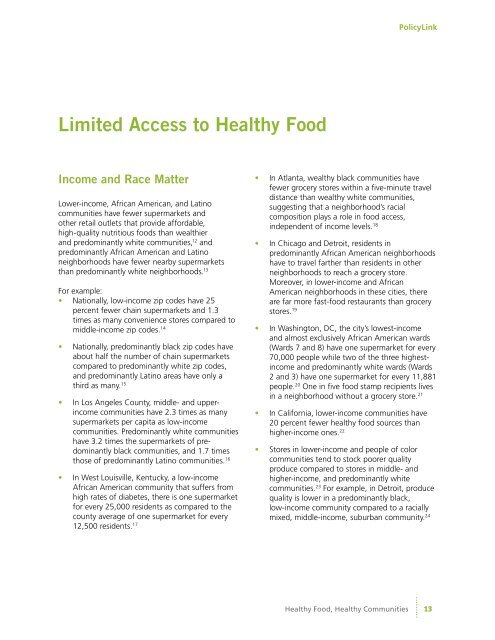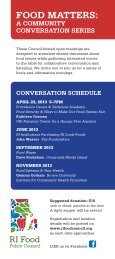Promising Strategies to Improve Access to Fresh, Healthy Food and ...
Promising Strategies to Improve Access to Fresh, Healthy Food and ...
Promising Strategies to Improve Access to Fresh, Healthy Food and ...
You also want an ePaper? Increase the reach of your titles
YUMPU automatically turns print PDFs into web optimized ePapers that Google loves.
PolicyLinkLimited <strong>Access</strong> <strong>to</strong> <strong>Healthy</strong> <strong>Food</strong>Income <strong>and</strong> Race Matter• In Atlanta, wealthy black communities havefewer grocery s<strong>to</strong>res within a five-minute traveldistance than wealthy white communities,Lower-income, African American, <strong>and</strong> Latinosuggesting that a neighborhood’s racialcommunities have fewer supermarkets <strong>and</strong>composition plays a role in food access,other retail outlets that provide affordable,independent of income levels. 18high-quality nutritious foods than wealthier<strong>and</strong> predominantly white communities, 12 <strong>and</strong>predominantly African American <strong>and</strong> Latinoneighborhoods have fewer nearby supermarketsthan predominantly white neighborhoods. 13For example:• In Chicago <strong>and</strong> Detroit, residents inpredominantly African American neighborhoodshave <strong>to</strong> travel farther than residents in otherneighborhoods <strong>to</strong> reach a grocery s<strong>to</strong>re.Moreover, in lower-income <strong>and</strong> AfricanAmerican neighborhoods in these cities, there• Nationally, low-income zip codes have 25percent fewer chain supermarkets <strong>and</strong> 1.3are far more fast-food restaurants than grocerys<strong>to</strong>res. 19times as many convenience s<strong>to</strong>res compared <strong>to</strong>middle-income zip codes. 14• In Washing<strong>to</strong>n, DC, the city’s lowest-income<strong>and</strong> almost exclusively African American wards• Nationally, predominantly black zip codes haveabout half the number of chain supermarketscompared <strong>to</strong> predominantly white zip codes,<strong>and</strong> predominantly Latino areas have only athird as many. 15(Wards 7 <strong>and</strong> 8) have one supermarket for every70,000 people while two of the three highestincome<strong>and</strong> predominantly white wards (Wards2 <strong>and</strong> 3) have one supermarket for every 11,881people. 20 One in five food stamp recipients lives• In Los Angeles County, middle- <strong>and</strong> upperincomein a neighborhood without a grocery s<strong>to</strong>re. 21communities have 2.3 times as manysupermarkets per capita as low-incomecommunities. Predominantly white communities• In California, lower-income communities have20 percent fewer healthy food sources thanhigher-income ones. 22have 3.2 times the supermarkets of predominantlyblack communities, <strong>and</strong> 1.7 timesthose of predominantly Latino communities. 16• S<strong>to</strong>res in lower-income <strong>and</strong> people of colorcommunities tend <strong>to</strong> s<strong>to</strong>ck poorer qualityproduce compared <strong>to</strong> s<strong>to</strong>res in middle- <strong>and</strong>• In West Louisville, Kentucky, a low-incomeAfrican American community that suffers fromhigh rates of diabetes, there is one supermarketfor every 25,000 residents as compared <strong>to</strong> thecounty average of one supermarket for every12,500 residents.higher-income, <strong>and</strong> predominantly whitecommunities. 23 For example, in Detroit, producequality is lower in a predominantly black,low-income community compared <strong>to</strong> a raciallymixed, middle-income, suburban community. 24<strong>Healthy</strong> <strong>Food</strong>, <strong>Healthy</strong> Communities13



